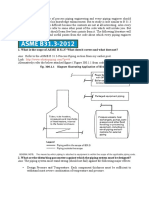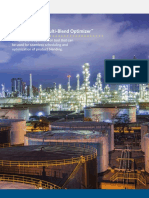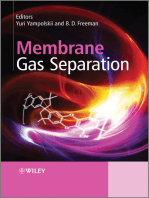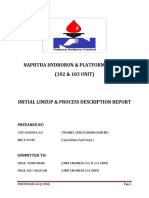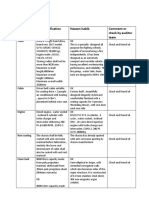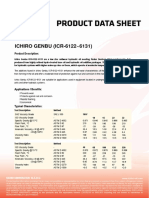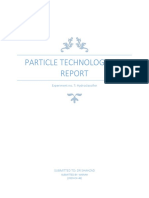Hazop Study: 11.1.1 Background
Hazop Study: 11.1.1 Background
Uploaded by
MuhammadCopyright:
Available Formats
Hazop Study: 11.1.1 Background
Hazop Study: 11.1.1 Background
Uploaded by
MuhammadOriginal Description:
Original Title
Copyright
Available Formats
Share this document
Did you find this document useful?
Is this content inappropriate?
Copyright:
Available Formats
Hazop Study: 11.1.1 Background
Hazop Study: 11.1.1 Background
Uploaded by
MuhammadCopyright:
Available Formats
CHAPTER 11 HazOp Study
HazOp Study
A hazard and operability study is a procedure for the systematic, critical, examination of the
operability of a process. When applied to a process design over an operating plant, it indicates
potential hazards that may arise from deviation from the intended design conditions
The technique was developed by petrochemical division of material chemical industry, see
Lawley(1974) and is now in general use in the chemical and process industry. The term
operability study more properly is used for this type of study, though it is usually referred to as
hazard and operability study or Hazop study. The formal operability study is the systematic study
of the design, vessel and line by line, using guide words to help generate throughout about the
way deviations from the intended operating conditions can cause hazardous situations.
11.1 General Description
11.1.1 Background:
A HazOp study identifies hazards and operability problems. The concept
involves investigating how the plant might deviate from the design intent. If, in the process of
identifying problems during a HazOp study, a solution becomes apparent, it is recorded as part of
the HazOp result; however, care must be taken to avoid trying to find solutions which are not so
apparent, because the prime objective for the HazOp is problem identification. Although the
HazOp study was developed to supplement experience-based practices when a new design or
technology is involved, its use has expanded to almost all phases of a plant's life. HazOp is based
on the principle that several experts with different backgrounds can interact and identify more
problems when working together than when working separately and combining their results.
The "Guide-Word" HazOp is the most well-known of the HazOps; however, several
specializations of this basic method have been developed. These specializations will be discussed
as modifications of the Guide-Word approach, but they are not to be regarded as less useful than
the Guide-Word approach. Indeed, in many situations these variations may be more effective
than the Guide-Word approach.
Hydrodesulfurization Of Diesel Page 170
CHAPTER 11 HazOp Study
11.1.2 Concept:
The HazOp concept is to review the plant in a series of meetings, during
which a multidisciplinary team methodically "brainstorms" the plant design, following the
structure provided by the guide words and the team leader's experience.
The primary advantage of this brainstorming is that it stimulates creativity and generates ideas.
This creativity results from the interaction of the team and their diverse backgrounds.
Consequently the process requires that all team members participate (quantity breeds quality in
this case), and team members must refrain from criticizing each other to the point that members
hesitate to suggest Ideas.
The team focuses on specific points of the design (called "study nodes"), one at a time. At each
of these study nodes, deviations In the process parameters are examined using the guide words.
The guide words are used to ensure that the design is explored In every conceivable way. Thus
the team must identify a fairly large number of deviations, each of which must then be
considered so that their potential causes and consequences can be identified.
The best time to conduct a HazOp is when the design is fairly firm. At this point, the design is
well enough defined to allow meaningful answers to the questions raised in the HazOp process.
Also, at this point it is still possible to change the design without a major cost. However, HazOps
can be done at any stage after the design is nearly firm. For example, many older plants are
upgrading their control and Instrumentation systems. There is a natural relationship between the
HazOp deviation approach and the usual control system design philosophy of driving deviations
to zero; thus It Is very effective to examine a plant as soon as the control system redesign is firm.
The success or failure of the HazOp depends on several factors:
The completeness and accuracy of drawings and other data used as a basis for the
study
The technical skills and insights of the team
The ability of the team to use the approach as an aid to their Imagination in
visualizing deviations, causes, and consequences
Hydrodesulfurization Of Diesel Page 171
CHAPTER 11 HazOp Study
The ability of the team to concentrate on the more serious hazards which are
identified.
The process is systematic and It Is helpful to define the terms that are used:
A. STUDY NODES - The locations (on piping and Instrumentation drawings and
procedures) at which the process parameters are investigated for deviations.
B. INTENTION - The intention defines how the plant is expected to operate in the absence of
deviations at the study nodes. This can take a number of forms and can either be descriptive or
diagrammatic; e.g., flow sheets, line diagrams, P&IDs.
C. DEVIATIONS - These are departures from the intention which are discovered by
systematically applying the guide words (e.g., "more pressure").
D. CAUSES - These are the reasons why deviations might occur. Once a deviation has been
shown to have a credible cause, it can be treated as a meaningful deviation. These causes can be
hardware failures, human errors, an unanticipated process state (e.g., change of composition),
external disruptions (e.g., loss of power), etc.
E. CONSEQUENCES - These are the results of the deviations should they occur (e.g.,
release of toxic materials). Trivial consequences, relative to the study objective, are dropped.
F. GUIDE WORDS - These are simple words which are used to qualify or quantify the
intention in order to guide and stimulate the brainstorming process and so discover deviations.
The guide words shown in Table 4-3 are the ones most often used in a HazOp; some
organizations have made this list specific to their operations, to guide the team more quickly to
the areas where they have previously found problems. Each guide word is applied to the process
variables at the point in the plant (study node) which is being examined. For example:
Hydrodesulfurization Of Diesel Page 172
CHAPTER 11 HazOp Study
Guide Words Parameter Deviation
NO FLOW NO FLOW
MORE PRESSURE HIGH PRESSURE
AS WELL AS ONE PHASE TWO PHASE
OTHER THAN OPERATION MAINTENANCE
These guide words are applicable to both the more general parameters (e.g., react, transfer) and
the more specific parameters (e.g., pressure, temperature).
TABLE: HAZOP GUIDE WORDS AND MEANINGS
Guide Words Meaning
No Negation of the Design Intent
Less Quantitative Decrease
More Quantitative Increase
Part Of Qualitative Decrease
As Well As Qualitative Increase
Reverse Logical Opposite of the Intent
Other Than Complete Substitution
Hydrodesulfurization Of Diesel Page 173
CHAPTER 11 HazOp Study
With the general parameters, meaningful deviations are usually generated for each guide word.
Moreover, it is not unusual to have more than one deviation from the application of one guide
word. For example, "more reaction" could mean either than a reaction takes place at a faster rate,
or that a greater quantity of product results. With the specific parameters, some modification of
the guide words may be necessary. In addition, it is not unusual to find that some potential
deviations are eliminated by physical limitation. For example, if the design intention of a
pressure or temperature is being considered, the guide words "more" or "less" may be the only
possibilities.
There are other useful modifications to guide words such as:
SOONER or LATER for OTHER THAN when considering time
WHERE ELSE for OTHER THAN when considering position, sources, or destination
HIGHER and LOWER for MORE and LESS when considering elevations, temperatures, or
pressures.
Finally, when dealing with a design Intention involving a complex set of interrelated plant
parameters (e.g., temperatures, reaction rates, composition, or pressure), it may be better to apply
the whole sequence of guide words to each parameter individually than to apply each guide word
across all of the parameters as a group. Also, when applying the guide words to a sentence it may
be more useful to apply the sequence of guide words to each word or phrase separately, starting
with the key part which describes the activity (usually the verbs or adverbs). These parts of the
sentence usually are related to some impact on the process parameters. For example, in the
sentence "The operator starts flow A when pressure B is reached", the guide words would be
applied to:
Flow A (no, more, less, etc.)
When pressure B is reached (sooner, later, etc.)
Hydrodesulfurization Of Diesel Page 174
CHAPTER 11 HazOp Study
11.2 HAZOP Analysis of HSD Plant
Keeping in view our limitations regarding the HAZOP analysis, what we are describing
in the subsequent text is a very brief overview of potential hazards and operability problems of
our process, their consequences along with additional implications of these consequences. Then
in the end the HAZOP studies for three equipment’s is tabulated in table 11.1.
Now, starting from the feed pump which is required to maintain a constant pressure head
of 1110 psia at a constant discharge flow rate, any abnormality in normal operating conditions of
flow, pressure or temperature can cause damage to the impeller of the pump, which would then
result in disturbed head and discharge flow rate. This will directly affect the reactor operation
where there is a process requirement of maintaining the specified pressure in order to ensure
required degree of hydrodesulphurization. Also the low discharge rates would result in drop of
liquid levels in the downstream vessels. If the discharge valve of pump falls close, the pressure
will increase in the pump discharge line and this would result in damaging the impeller and other
pump internals initially but prevailing this situation for some time would result in explosion and
complete pump failure. If the valve at the inlet of the pump fails close then this will result in the
cavitation of pump. These consequences along with other consequences are given in table 11.1 at
the end of this article.
Compressor is required to maintain the pressure of treat gas inside the reactor. The
positioning of discharge valve is very critical in case of compressor. If the instrument air of
discharge valve fails and the valve shuts down, this would result in hammering inside the
compressor and since the pressure developed is very high, it would result in compressor failure
which might result in an explosion as well. Also, if the flow rate of coolant in inter-stage cooler
cuts off, the heat generated in single stage of compressor will not be removed, as a consequence
of this the volume of gas entering the next stage will increase and hence, the compression will
decrease. So, not only the discharge pressure will decrease but also the seals and impellers will
be worn out due to excessive heating. This disturbed pressure will also disturb overall plant
operation, due to which the final product composition will also change. If the inlet valve of the
compressor is closed by any means or the flow rate of make-up gas decreases this will result in
low hydrogen partial pressure inside the reactor, ultimately this can result in destruction of
catalyst beds inside the reactor.
Hydrodesulfurization Of Diesel Page 175
CHAPTER 11 HazOp Study
The direct fired heater or furnace is the major source of energy in our process. Any
abnormal operation of this unit may have some serious implications to our process. If the flow
rate of fuel increases due to sudden opening of valve, the flame temperature may drastically
increase which could cause an excessive heating and would result in higher process stream
temperature. Higher feed temperature would not only damage our catalyst in the reactor, which is
quite valuable to us, but also disturb product specifications. If the fuel line ruptures, this will
cause leakage of gas which would pose a serious threat of external fire and less heating of
process fluid would disturb reactor conditions. Also, the excessive heating of furnace tubes may
result in excessively high tube skin temperatures and rising of temperature above a particular
value would result in rupturing of tubes. This is a very serious threat because our process fluid is
highly combustible and any possible internal leakages could result in huge explosion.
Reactor is heart of any process. Since, reactor in our process is a trickle bed reactor; a
uniform flow distribution is required to ensure specified hydrotreating. If the discharge line of
reactor ruptures, this would adversely affect the operation of subsequent separators because
required level of liquid cannot then be maintained. This would result in poor separation in
separators. Any negative change in the flow rate of quench gas will result in temperature increase
in inter-bed spaces, which will result in sintering of catalyst beds.
In hot high pressure separator, a certain level of liquid is required to ensure equilibrium
establishment and separation of gas from liquid. If the discharge line ruptures, the level of liquid
will fall rapidly and not only the separation will disturb because of difficulty in the establishment
of equilibrium but also the next separator will run dry. If the outlet valve in the liquid discharge
line closes, the level of liquid starts to rise inside the vessel and after some time whole volume
will be occupied by liquid leaving no space for vapors and hence ceases the flow throughout the
process. Similarly, if the vapor discharge valve shuts off, the pressure inside the vessel will
increase and would result in vessel rupturing. If the gas discharge valve fails open, this will result
in the drop of pressure inside the vessel will result in disturbance of equilibrium inside the
vessel.
Further separation of vapors from liquid is achieved in cold high pressure separator. Over
head vapors coming from HHPS are condensed and water is added into this stream before it
enters into CHPS. If water supply cuts off, the temperature of vapor liquid stream entering the
separator will increase which will disturb the conditions in CHPS. This would in turn affect the
Hydrodesulfurization Of Diesel Page 176
CHAPTER 11 HazOp Study
degree separation. Water is actually added to dissolve NH3 and some H2S present in the inlet
stream in the form of ammonium sulphide precipitates which could cause severe corrosion
problems. So, the decreased flowrate of water will increase the corrosion rate in the separator.
Here, if the discharge line ruptures or valve malfunctions, the required level of liquid which
should be maintained at certain level to ensure required separation will drop down posing serious
threats to normal operation.
If flow rate of DEA in absorber is disturbed, this will decrease the H2S removal and its
high concentration in the recycle gas will accelerate the rate of corrosion and will adversely
affect the catalyst inside reactor. Also the low DEA flow rate may cause the flooding condition
to prevail in the column. If the pressure of DEA decreases due to any failure of amine pump, the
H2S removal will be largely affected because absorption is favored at high pressure. If the
flowrate if DEA increases, this can result in weeping of column.
As already mentioned in the beginning of this article, this is just the bird’s eye view of
HAZOP. Since the complete analysis requires the complete Instrumentation and Control
diagrams, Cause & Effect Charts setting out how control and trip systems operate, Details of
vendor packages if available and Plant layout diagrams. So, all the information given above may
render errors. In the following table HAZOP analysis of feed pump P-110, make-up gas
compressor K-110 and separation vessel V-110 is given.
Hydrodesulfurization Of Diesel Page 177
CHAPTER 11 HazOp Study
Equipment Deviations What Event Consequences of Additional
Reference and from Could this Deviation on Implications of
Operating Operating Cause this Item of this
Conditions Conditions Deviation Equipment Consequence
Under
Consideration
Feed Pump P- Flow
110
Less Inlet valve Pump cavitates Damage to pump
closed
Outlet valve Deadhead pump Damage to pump
closed
Line plugs Pump cavitates Damage to pump
FV-1 fails Deadhead pump Damage to pump
closed
FICA-1 fails Deadhead pump Damage to pump
closing FV-1
Drain valve Diesel released
open
More FV-1 fails Upset in Diesel released
open downstream
process
FICA-1 fails Upset in Diesel released
opening FV- downstream
1 process
Hydrodesulfurization Of Diesel Page 178
CHAPTER 11 HazOp Study
Pressure
More Outlet valve Deadhead pump Damage to pump
closed
FV-1 fails Deadhead pump Damage to pump
closed
FICA-1 fails Deadhead pump Damage to pump
closing FV-1
Inlet and Deadhead pump Overpressure in
outlet valve pump or line
closed
Less Inlet valve Pump cavitates Damage to pump
closed
Drain valve Diesel released
open
Temperature
More Outlet valve Deadhead pump Damage to pump
closed
FV-1 fails Deadhead pump Damage to pump
closed
FICA-1 fails Deadhead pump Damage to pump
closing FV-1
Hydrodesulfurization Of Diesel Page 179
CHAPTER 11 HazOp Study
Make up gas Flow
compressor K-
110
Less Inlet valve Compressor Damage to
closed surges compressor
Outlet valve Deadhead Damage to
closed compressor compressor
Line plugs Compressor Damage to
surges compressor
FV-2 fails Deadhead Damage to
closed compressor compressor
FICA-2 fails Deadhead Damage to
closing FV-2 compressor compressor
Safety valve Make-up gas
open released
More FV-2 fails Upset in Diesel released
open downstream
process
FICA-2 fails Upset in Diesel released
opening FV- downstream
2 process
Pressure
More Outlet valve Deadhead Damage to
closed compressor compressor
FV-2 fails Deadhead Damage to
closed compressor compressor
Hydrodesulfurization Of Diesel Page 180
CHAPTER 11 HazOp Study
FICA-2 fails Deadhead Damage to
closing FV-2 compressor compressor
Inlet and Deadhead Overpressure in
outlet valve compressor pump or line
closed
Less Inlet valve Compressor Damage to
closed surges compressor
Safety valve Make-up gas
open released
Temperature
More Outlet valve Deadhead Damage to
closed compressor compressor
FV-2 fails Deadhead Damage to
closed compressor compressor
FICA-2 fails Deadhead Damage to
closing FV-2 compressor compressor
Separation Level
Vessel V-110
Less Liquid Disturbance in outlet vapor and
discharge equilibrium liquid
valve fails establishment compositions
open disturb
discharge
line
ruptures.
Hydrodesulfurization Of Diesel Page 181
CHAPTER 11 HazOp Study
discharge Disturbance in outlet vapor and
line equilibrium liquid
ruptures. establishment compositions
disturb
Inlet valve Disturbance in outlet vapor and
closes equilibrium liquid
establishment compositions
disturb
More Outlet valve Disturbance in outlet vapor and
closes equilibrium liquid
establishment compositions
disturb
Inlet flow Disturbance in outlet vapor and
increases equilibrium liquid
establishment compositions
disturb
Pressure
Less Vapor outlet Equilibrium is outlet vapor and
valve fail disturbed liquid
open. compositions
disturb
More Vapor outlet Equilibrium is outlet vapor and
valve fails disturbed liquid
close compositions
disturb
Hydrodesulfurization Of Diesel Page 182
CHAPTER 11 HazOp Study
Temperature
Less Temperature Possible vacuum. Thermal stress
of inlet is on tank.
colder than
normal.
More Temperature Excessive vapor Thermal stress
of inlet is stream on tank.
hotter than
normal
External fire Tank fails Reagent released
Hydrodesulfurization Of Diesel Page 183
You might also like
- R 56Document6 pagesR 56MuhammadNo ratings yet
- Chlor Alkali FinalDocument12 pagesChlor Alkali FinalAyu ErlizaNo ratings yet
- Tension Test: Lab Report 1 1Document9 pagesTension Test: Lab Report 1 1Санжар ЖумаханNo ratings yet
- Permeate Recycle To Improve The Performance of A Spiral-Wound RO PlantDocument8 pagesPermeate Recycle To Improve The Performance of A Spiral-Wound RO Planttata_77No ratings yet
- Nowak 1966Document9 pagesNowak 1966adedwi utamaNo ratings yet
- Project 6 AmmoniaDocument10 pagesProject 6 AmmoniaAhmed AliNo ratings yet
- 13 KEROSENE MEROX PROCEDURE LatestDocument7 pages13 KEROSENE MEROX PROCEDURE LatestMuhammadNo ratings yet
- R56 - MSDSDocument9 pagesR56 - MSDSMuhammad100% (1)
- Compresores de Tornillo KobelcoDocument6 pagesCompresores de Tornillo Kobelcocristobal_tl2277No ratings yet
- 11 Most Important Questions & Answers From ASME B 31.3 Which A Piping Stress Engineer Must KnowDocument6 pages11 Most Important Questions & Answers From ASME B 31.3 Which A Piping Stress Engineer Must KnowRakesh RanjanNo ratings yet
- TheChlor AlkaliProcess WorkInProgressDocument19 pagesTheChlor AlkaliProcess WorkInProgressjaseem1250No ratings yet
- Development of High Performance Vinyl Acetate Monomer (VAM) CatalystsDocument136 pagesDevelopment of High Performance Vinyl Acetate Monomer (VAM) Catalystsmanav mistryNo ratings yet
- 3164 PDFDocument133 pages3164 PDFnoelNo ratings yet
- Hariom ReportDocument60 pagesHariom Reportहरिओम हरी100% (2)
- Economic Analysis of Phosphoric Acid ExtractionDocument34 pagesEconomic Analysis of Phosphoric Acid ExtractionRiham loubaniNo ratings yet
- Production of Hydrogen Gas From Refinery Off-Gas StreamDocument75 pagesProduction of Hydrogen Gas From Refinery Off-Gas Streamيزيد العزانيNo ratings yet
- Production of Acetic AcidDocument28 pagesProduction of Acetic AcidAl NazreenNo ratings yet
- Anisole SynthesisDocument6 pagesAnisole SynthesisManoj Tiwari0% (1)
- Abdel Aal2004Document8 pagesAbdel Aal2004Erika Desi CahyaniNo ratings yet
- Urea Plant Material Balance ACES ProcessDocument5 pagesUrea Plant Material Balance ACES ProcessSTEFAN TOTHNo ratings yet
- Advancements in Sulfur Recovery ProcessesDocument21 pagesAdvancements in Sulfur Recovery Processesprateek kumarNo ratings yet
- Descripsi Process Direct Neutralization Oe Synthetic ManufactureDocument9 pagesDescripsi Process Direct Neutralization Oe Synthetic Manufacturerifqi fatmalaNo ratings yet
- Urea Manufacturing 1Document46 pagesUrea Manufacturing 1Sho aibNo ratings yet
- Solar Photovoltaic Based Water Electrolysis System To Generate Hydrogen and OxygenDocument11 pagesSolar Photovoltaic Based Water Electrolysis System To Generate Hydrogen and OxygenIJRASETPublicationsNo ratings yet
- Ammonia Stripping MethodDocument2 pagesAmmonia Stripping MethodsagbvnNo ratings yet
- A Term Paper Report OnDocument42 pagesA Term Paper Report OnmohanrtamNo ratings yet
- Benzene, C10-C16 Alkyl Derivatives: ForewordDocument79 pagesBenzene, C10-C16 Alkyl Derivatives: Forewordlank_curlyNo ratings yet
- MS C 06 PlasterinDocument4 pagesMS C 06 PlasterinYENDRU LALITHAKUMARINo ratings yet
- 2008 Morikawa TEC IFA ACES21 Advanced Urea Production Technology - 2Document15 pages2008 Morikawa TEC IFA ACES21 Advanced Urea Production Technology - 2MubasharNo ratings yet
- Control of Evaporator in The Production of UreaDocument15 pagesControl of Evaporator in The Production of Ureatariq fareedNo ratings yet
- OTS Ammonia Urea Profertil ArgentinaDocument16 pagesOTS Ammonia Urea Profertil ArgentinaGeorge Van BommelNo ratings yet
- Ammonia Storage Tank in Kaltim 1: Operation Matters: Hanggara PatriantaDocument8 pagesAmmonia Storage Tank in Kaltim 1: Operation Matters: Hanggara Patriantavaratharajan g rNo ratings yet
- Cepci 2008 2015 PDFDocument2 pagesCepci 2008 2015 PDFArum Puspa SeruniNo ratings yet
- Process Economics Program: ChemicalDocument9 pagesProcess Economics Program: ChemicalRamadan AhmedNo ratings yet
- 10.2.2 PCS Phosphate's New 4500 STPD Sulfuric Acid Plant in AuroraDocument20 pages10.2.2 PCS Phosphate's New 4500 STPD Sulfuric Acid Plant in AuroraCarlosNo ratings yet
- Excess Air (Metal Oxide Catalyst) ProcessDocument14 pagesExcess Air (Metal Oxide Catalyst) ProcessJuarez ReisNo ratings yet
- PEB4102 Chapter 4 - UpdatedDocument79 pagesPEB4102 Chapter 4 - UpdatedLimNo ratings yet
- Phospheric Acid Report Phase-2 PDFDocument75 pagesPhospheric Acid Report Phase-2 PDF79Jay ShethNo ratings yet
- The Cativa'' Process For The Manufacture Plant of Acetic AcidDocument12 pagesThe Cativa'' Process For The Manufacture Plant of Acetic AcidPragadeeshNo ratings yet
- Group2 Pde ProjectDocument28 pagesGroup2 Pde ProjectPraveen jangidNo ratings yet
- POWER Magazine - May 2023-1Document43 pagesPOWER Magazine - May 2023-1MarcialgonzalezpNo ratings yet
- Benzene To CyclohexaneDocument16 pagesBenzene To Cyclohexanekalwani20No ratings yet
- Urea ModelingDocument20 pagesUrea ModelingekmagisNo ratings yet
- Performance A Commercial Scale 1 4 % Hole Area Sieve TrayDocument6 pagesPerformance A Commercial Scale 1 4 % Hole Area Sieve TrayapitbhuNo ratings yet
- Modeling and Simulation of High-Pressure Urea Synthesis LoopDocument10 pagesModeling and Simulation of High-Pressure Urea Synthesis LoopahmadNo ratings yet
- Guidelines For Based Organic Chemicals ManufacturingDocument31 pagesGuidelines For Based Organic Chemicals Manufacturingสาธิต ปริ นทร์ทองNo ratings yet
- CaprolactamDocument4 pagesCaprolactamArchie HisolerNo ratings yet
- Lecture2 (3) AsdsvDocument6 pagesLecture2 (3) AsdsvArun SinghNo ratings yet
- Integrated Process For Potassium SulfateDocument13 pagesIntegrated Process For Potassium SulfateKhereddine Ben AmmarNo ratings yet
- Nano Ureathe Philosophyof FutureDocument9 pagesNano Ureathe Philosophyof Futurerob100% (1)
- VCM Production FinalDocument106 pagesVCM Production FinalMuhammad UmairNo ratings yet
- Ammonium Sulphate ModifiedDocument13 pagesAmmonium Sulphate ModifiedNitin MohandasNo ratings yet
- The Chlor-Alkali Industry and Chemical IndustryDocument15 pagesThe Chlor-Alkali Industry and Chemical IndustryDeepugopalakrishnan100% (1)
- Catalytic Conversion of Glycerol To Oxygenated Fuel Additive in A Continuos Flow Reactor - Process OptimizationDocument7 pagesCatalytic Conversion of Glycerol To Oxygenated Fuel Additive in A Continuos Flow Reactor - Process OptimizationEduardo CarmineNo ratings yet
- The Urea Manufacturing ProcessDocument5 pagesThe Urea Manufacturing ProcessJhonny Huanca ChampiriNo ratings yet
- UreaDocument11 pagesUreanitishNo ratings yet
- Innovative Approach in Fertiliser Production at GSFC SikkaDocument8 pagesInnovative Approach in Fertiliser Production at GSFC SikkaPinak VadherNo ratings yet
- Aspen Refinery Multi-Blend OptimizerDocument4 pagesAspen Refinery Multi-Blend OptimizerMaria OliveiraNo ratings yet
- The Operating Experience of Nitrophosphate Plant PDFDocument6 pagesThe Operating Experience of Nitrophosphate Plant PDFasad100% (2)
- An Industrial Design Control Study For VAC Monomer Process PDFDocument11 pagesAn Industrial Design Control Study For VAC Monomer Process PDFPY YouNo ratings yet
- In-situ Characterization of Heterogeneous CatalystsFrom EverandIn-situ Characterization of Heterogeneous CatalystsJosé A. RodriguezNo ratings yet
- Membrane Gas SeparationFrom EverandMembrane Gas SeparationBenny FreemanNo ratings yet
- Quantitative Risk Assessment A Complete Guide - 2020 EditionFrom EverandQuantitative Risk Assessment A Complete Guide - 2020 EditionNo ratings yet
- Polymer Reaction EngineeringFrom EverandPolymer Reaction EngineeringJose AsuaNo ratings yet
- 11 PDFDocument14 pages11 PDFMuhammadNo ratings yet
- Official IELTS Practice Materials 1 PDFDocument36 pagesOfficial IELTS Practice Materials 1 PDFMuhammadNo ratings yet
- 6 PDFDocument20 pages6 PDFMuhammadNo ratings yet
- Book To Study in ClassDocument25 pagesBook To Study in ClassMuhammadNo ratings yet
- Uuuu PDFDocument15 pagesUuuu PDFMuhammadNo ratings yet
- Instrumentation and Control: 10.1 ObjectivesDocument8 pagesInstrumentation and Control: 10.1 ObjectivesMuhammadNo ratings yet
- GOM 13 Special Procedures-RegenDocument64 pagesGOM 13 Special Procedures-RegenMuhammadNo ratings yet
- 14 H.N+L.N MEROX PROCEDURE LatestDocument8 pages14 H.N+L.N MEROX PROCEDURE LatestMuhammadNo ratings yet
- Hydrodesulfurization of Diesel: CHAPTER 1 IntroductionDocument6 pagesHydrodesulfurization of Diesel: CHAPTER 1 IntroductionMuhammadNo ratings yet
- 102 & 103 Hydrotreater ReportDocument31 pages102 & 103 Hydrotreater ReportMuhammadNo ratings yet
- Hydrant ReportDocument12 pagesHydrant ReportMuhammadNo ratings yet
- Amine Gas TreatingDocument3 pagesAmine Gas TreatingMuhammadNo ratings yet
- Endress-Hauser Flowfit W CPA250 enDocument3 pagesEndress-Hauser Flowfit W CPA250 enSyazaNo ratings yet
- Alfa Laval U BendDocument23 pagesAlfa Laval U BendPRASANNANo ratings yet
- Esp PVT-PropertiesDocument17 pagesEsp PVT-PropertiesJSN179No ratings yet
- Elsevier - Sensitivity of Joule Thomson Cooling To Impure CO2 Injection in Depleted Gas Reservoirs - Ziabakhsh - Ganji - 2013Document18 pagesElsevier - Sensitivity of Joule Thomson Cooling To Impure CO2 Injection in Depleted Gas Reservoirs - Ziabakhsh - Ganji - 2013wordindustriesNo ratings yet
- Anna University CHENNAI - 600 025: B.Tech. Chemical Engineering (Full Time)Document113 pagesAnna University CHENNAI - 600 025: B.Tech. Chemical Engineering (Full Time)Abner kolinNo ratings yet
- Datasheet RefDem58219080-3400-30 en 120V 60Hz-2Document7 pagesDatasheet RefDem58219080-3400-30 en 120V 60Hz-2Floyd PriceNo ratings yet
- SF - Válvual de PreenchimentoDocument16 pagesSF - Válvual de PreenchimentoBademianNo ratings yet
- A Sensitivity Study of Gas Turbine Exhaust Diffuser-Collector Performance at Various Inlet Swirl Angles and Strut Stagger AnglesDocument15 pagesA Sensitivity Study of Gas Turbine Exhaust Diffuser-Collector Performance at Various Inlet Swirl Angles and Strut Stagger Angleskien nguyenNo ratings yet
- The Thin Film Approximation in Hydrodynamic, Including Elastohydrodynamic, LubricationDocument43 pagesThe Thin Film Approximation in Hydrodynamic, Including Elastohydrodynamic, Lubricationحسين مهديNo ratings yet
- Solar Energy: Mustafa Aktas SS, Seyfi S SSevik, Ali Amini, Ataollah KhanlariDocument16 pagesSolar Energy: Mustafa Aktas SS, Seyfi S SSevik, Ali Amini, Ataollah KhanlariVerónica Sanabria DomínguezNo ratings yet
- Apm LidDocument23 pagesApm LidNgô Nguyễn Huy AnhNo ratings yet
- Sistema Diesel 1 PDFDocument13 pagesSistema Diesel 1 PDFstalin vNo ratings yet
- 5 - Secondary Treatment - Activated SludgeDocument39 pages5 - Secondary Treatment - Activated SludgeTalat AhmedNo ratings yet
- 2 Drilling Fluid Properties-Lecture-2Document54 pages2 Drilling Fluid Properties-Lecture-2أبراهيم كريم كاظمNo ratings yet
- Reverse Osmosis: Boiler Water Operator Training NotesDocument6 pagesReverse Osmosis: Boiler Water Operator Training NotesSheikh SahabNo ratings yet
- METRUS Test Bench Overview 2017Document8 pagesMETRUS Test Bench Overview 2017Ozawa Magoo100% (1)
- Industrial Boiler Project Final ReportDocument34 pagesIndustrial Boiler Project Final Reportvanshita7020No ratings yet
- PDF P&idDocument77 pagesPDF P&iderik nara100% (2)
- Unit 24: Applications of Pneumatics and HydraulicsDocument15 pagesUnit 24: Applications of Pneumatics and HydraulicsEmad ElsaidNo ratings yet
- Etanorm Curva 60hzDocument164 pagesEtanorm Curva 60hzAmandha CarvalhoNo ratings yet
- ICHIRO GENBU (ICR-6122 6131) : Product DescriptionDocument2 pagesICHIRO GENBU (ICR-6122 6131) : Product DescriptiondnoaisapsNo ratings yet
- Centrifugal Pump - CatalogueDocument152 pagesCentrifugal Pump - CatalogueKOWSHIK 4310No ratings yet
- Tabla Vida Util de Valvulas y CilindrosDocument1 pageTabla Vida Util de Valvulas y CilindrosFernando GómezNo ratings yet
- All MCQDocument11 pagesAll MCQSakshi KumariNo ratings yet
- HydroclassifierDocument14 pagesHydroclassifierWariah ParvezNo ratings yet
- Packaged and VRV Xpress Presentations - Verosh CantubaDocument32 pagesPackaged and VRV Xpress Presentations - Verosh CantubaVerosh CantubaNo ratings yet
- Coating Equipment: by J. Raja SekharDocument24 pagesCoating Equipment: by J. Raja SekharRajasekhar JampaniNo ratings yet









